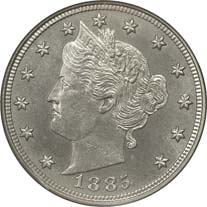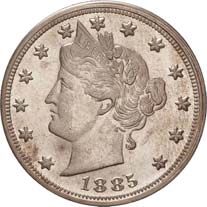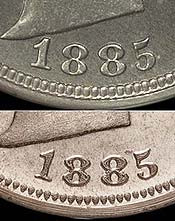Counterfeit Proof 1885 Liberty Nickel
Posted on 10/9/2009
Recently this unusual fake, believed to be of new manufacture, has appeared in NGC submissions. Although not particularly deceptive, NGC has received a handful of them. Our best guess as to why: it’s not a coin that anyone really would expect to be counterfeited. It demonstrates that fakes of just about every issue exist and it’s worthwhile to be vigilant when buying uncertified coins or from an unfamiliar source.
 |
 |
|
Proof 1885 Liberty Nickel. The genuine example is on the left and the counterfeit is on the right. Click image to enlarge |
|
There are obvious clues that identify this 1885 nickel as a fake. First, the devices (design elements) show a pebbled or rough texture that is unlike that seen on any authentic examples. Knowing the texture of a coin’s surface does require a degree of familiarity with authentic examples, but it can also be the easiest telltale of a fake. Authentic proof Liberty Nickels have crisp design features and smooth or very, very fine grained devices. Large nooks and crannies visible throughout the design are the hallmarks of this copy. Compare an enlargement of the date area with that of a genuine example — the real coin is on top.
 |
|
| Click image to enlarge | |
The second giveaway that this coin is bad is the shallowness of its design elements. Note how the Liberty’s ear dissolves into the fields. Same with the hair detail above her temple and at top of her neck. The shape of these elements will be crisp on an authentic specimen and clearly separate from the fields with a sharp delineation. Other elements of the design are similarly not crisp. Look at the stars. On genuine proofs, the intersecting lines will be clear. Here, the first star is especially weak and the others are rounded and amorphous.
Learning to pick out clues like those mentioned above are a great starting point to spotting fakes.
Stay Informed
Want news like this delivered to your inbox once a month? Subscribe to the free NGC eNewsletter today!